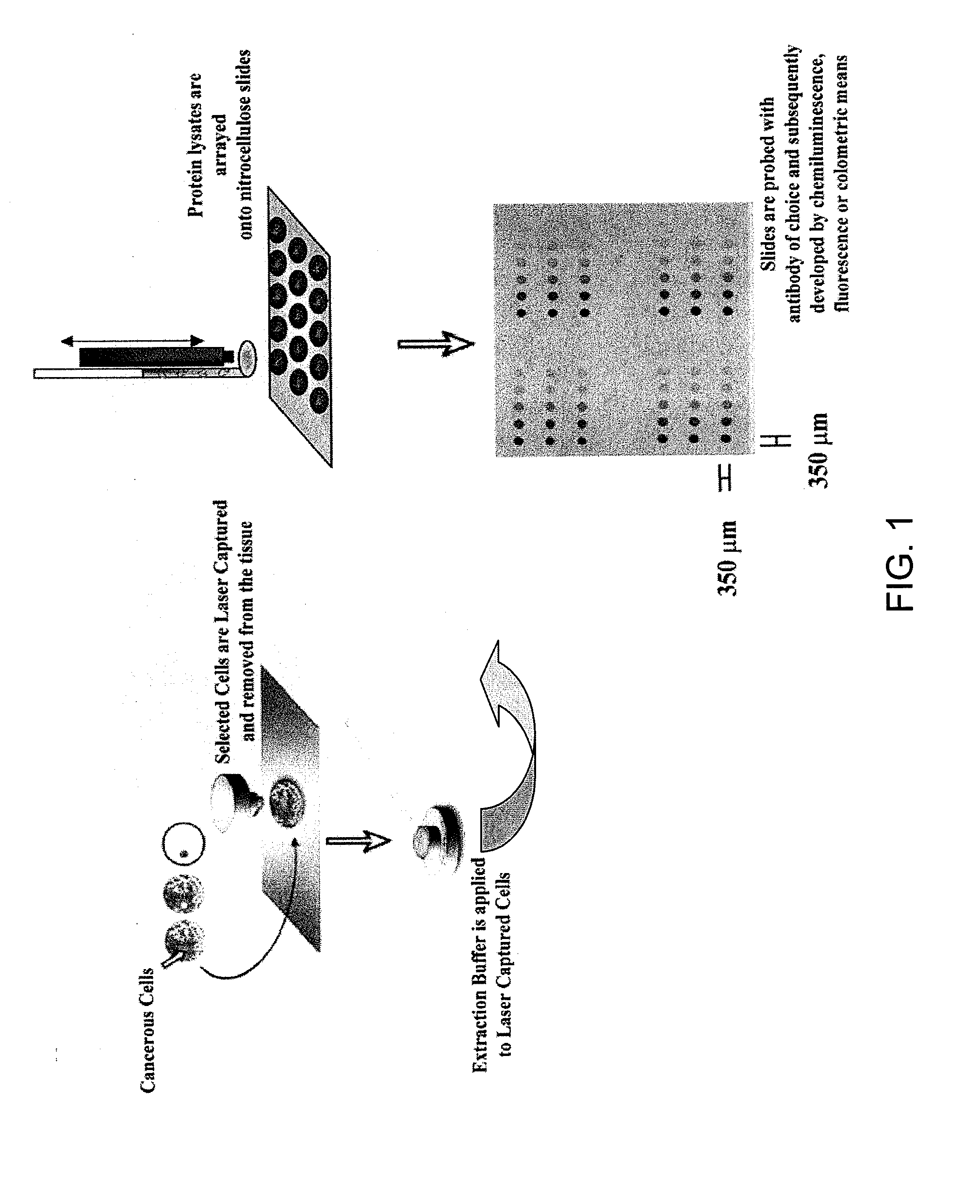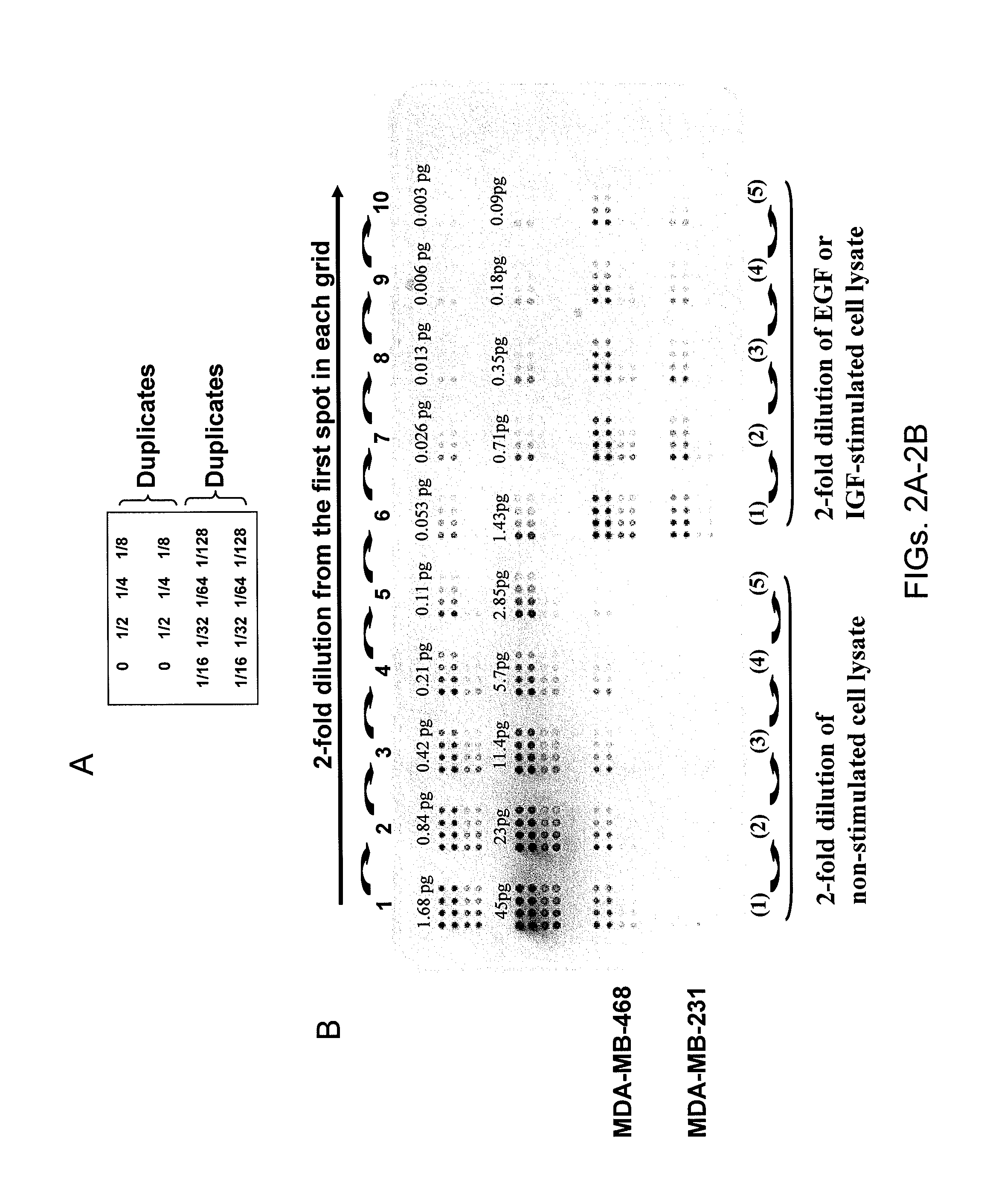Proteomic Patterns of Cancer Prognostic and Predictive Signatures
- Summary
- Abstract
- Description
- Claims
- Application Information
AI Technical Summary
Benefits of technology
Problems solved by technology
Method used
Image
Examples
example 1
RPPA Methods And Analyses
[0092] RPPA Method: General methods for RPPA are exemplified in FIG. 1. Protein lysates will be obtained by mixing tissue sample material with 1 ml of lysis buffer / 40 milligrams of frozen tissue and then serially diluted (8 serial dilutions: full strength, ½, ¼, ⅛, 1 / 16, 1 / 32, 1 / 64, 1 / 128) with additional lysis buffer. Dilutions will be made with Tecan liquid handling robot. This material is printed onto nitrocellulose-coated glass slides (FAST Slides, Schleicher & Schuell BioScience, Inc. USA, Keene, N.H.) with an automated GeneTac arrayer (Genomic Solutions, Inc., Ann Arbor, Mich.) that transfers 1 nl of protein lysate per touch. As many as 80 samples can be spotted in 8 serial dilutions on a single slide. The serial dilutions provide a slope and intercept allowing relative quantification of individual proteins. This is compared to control peptides (in house) allowing absolute quantification (see FIGS. 2A-2B). After slide printing, the same stringent cond...
example 2
Predictive Markers For Breast Cancer Prognosis
[0097] An algorithm is developed to predict clinical outcome in patients with hormone receptor positive breast cancer. The algorithm is developed and validated in a set of breast tumors and uses 5 protein markers: estrogen receptor (ER), progesterone receptor (PR), and phosphorylation of Akt, p38, and mammalian target of rapamycin (mTor). ER is currently assayed as a dichotomous variable and the validity of this approach is being questioned at present by, for example, the Food and Drug Administration. Lysate arrays treat ER as a continuous variable and data suggests that the quantity of ER protein is a major driver of outcome after anti-hormonal therapy for hormone receptor-positive breast cancer. Thus, ER quantification using lysate array technology may be capable of improving upon the current immunohistochemical assays for determining the hormone responsiveness of breast tumors.
[0098] Reverse phase tissue lysate arrays and Microvigen...
example 3
Predictive Markers For Ovarian Cancer Prognosis
[0105] Ovarian cancer prognostic and predictive signatures are developed using reverse phase tissue lysate array-based quantification of the expression and activation of protein members of kinase signaling pathways (e.g., phosphatidylinositol-3-kinase (PI3K) / Akt and mitogen activated protein kinase (MAPK)) and steroid signaling pathways. Signatures may be useful as a guide to patient prognosis and also for prediction of the likelihood that individuals with ovarian cancer will derive benefit from specific chemotherapies and potentially targeted therapies. Reverse phase tissue lysate arrays and Microvigene software™ are used to quantify the expression of estrogen receptor alpha (ER), progesterone receptor (PR), and 36 total / activated components of the HER2, phosphatidylinositol-3-kinase (PI3K), mitogen-activated protein kinase (MAPK), and STAT pathways in a test set of 44 human ovarian cancers (FIG. 4) and a validation set of 28 human ov...
PUM
 Login to View More
Login to View More Abstract
Description
Claims
Application Information
 Login to View More
Login to View More - R&D
- Intellectual Property
- Life Sciences
- Materials
- Tech Scout
- Unparalleled Data Quality
- Higher Quality Content
- 60% Fewer Hallucinations
Browse by: Latest US Patents, China's latest patents, Technical Efficacy Thesaurus, Application Domain, Technology Topic, Popular Technical Reports.
© 2025 PatSnap. All rights reserved.Legal|Privacy policy|Modern Slavery Act Transparency Statement|Sitemap|About US| Contact US: help@patsnap.com



